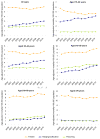Increase in suicide by hanging/suffocation in the U.S., 2000-2010
- PMID: 23332330
- PMCID: PMC3553495
- DOI: 10.1016/j.amepre.2012.10.010
Increase in suicide by hanging/suffocation in the U.S., 2000-2010
Abstract
Background: Recently, suicide exceeded motor vehicle crashes as the leading cause of injury death in the U.S. However, details of this change in suicide methods and the relationship to individual demographics, such as age and societal influences, have not been reported.
Purpose: To determine the characteristics of the changes in suicide rates between 2000 and 2010.
Methods: Data came from CDC's Web-Based Injury Statistics Query and Reporting System (WISQARS™). Line charts were plotted to reveal changes in suicide rates by firearm, poisoning, and hanging/suffocation (ICD-10 codes: X72-X74, X60-X69, and X70). The measure of change used is the percentage change in suicide rate between 2000 and 2010.
Results: The overall suicide rate increased from 10.4 to 12.1 per 100,000 population between 2000 and 2010, a 16% increase. The majority of the increase was attributable to suicide by hanging/suffocation (52%) and by poisoning (19%). Subgroup analysis showed: (1) suicide by hanging/suffocation increased by 104% among those aged 45-59 years and rose steadily in all age groups except those aged ≥70 years; (2) the largest increase in suicide by poisoning (85%) occurred among those aged 60-69 years; and (3) suicide by firearm decreased by 24% among those aged 15-24 years but increased by 22% among those aged 45-59 years. The case fatality rates for suicide by hanging/suffocation during 2000-2010 ranged from 69% to 84%, close to those for suicide by firearm. Analyses were conducted in 2012.
Conclusions: Substantial increases in suicide by hanging/suffocation and poisoning merit attention from policymakers and call for innovations and changes in suicide prevention approaches.
Copyright © 2013 American Journal of Preventive Medicine. Published by Elsevier Inc. All rights reserved.
Figures
References
-
- CDC, National Center for Injury Prevention and Control. Web-based Injury Statistics Query and Reporting System (WISQARS) www.cdc.gov/ncipc/wisqars.
-
- Hu G, Wilcox HC, Wissow L, Baker SP. Mid-life suicide: an increasing problem in U.S. whites, 1999–2005. Am J Prev Med. 2008;35(6):589–93. Erratum: Am J Prev Med 2009, 37, 6–579. - PubMed
-
- Ruhm CJ. Are recessions good for your health? Q J Econ. 2000;115(2):617–50.
Publication types
MeSH terms
Grants and funding
LinkOut - more resources
Full Text Sources
Other Literature Sources
Medical
Miscellaneous


